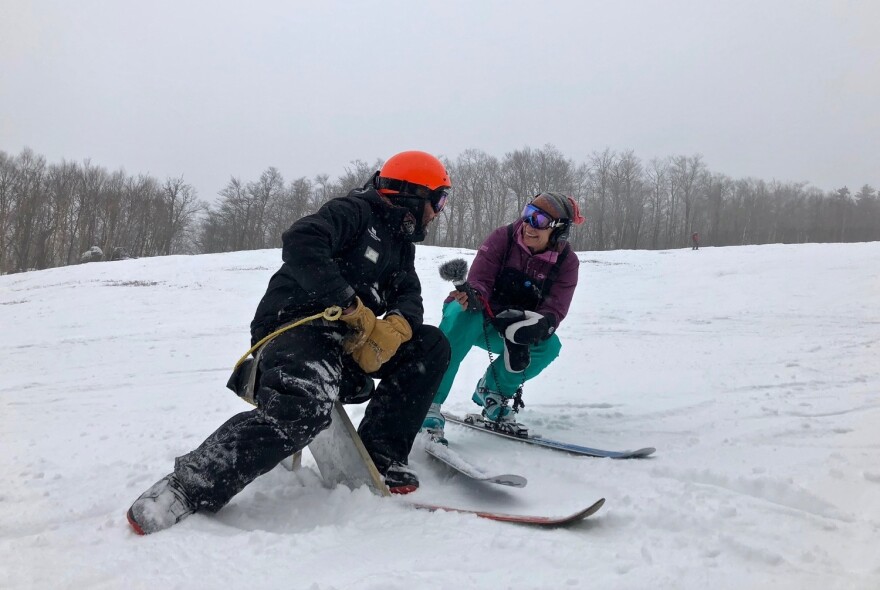On Sunday, dozens of competitors will take to the slopes at Mount Snow in Vermont for the annual world championship of jack jumping.
Wait. What's a jack jump? Yeah, I wondered that too.
Even as a longtime skier — and Vermont reporter — I had no idea what the snow sport entailed — but I became determined to find out.
Basically, a jack jump is a ski with a seat bolted on to it. Some are tricked out with fancy suspension, like the kind you see on a mountain bike. Some may even use a snowboard, but most are homemade.
Enthusiasts say the sport, known as Skibock in Europe, dates back to late 19th century, when French-Canadian loggers in the Green Mountains rode proto-jump jacks as a mode of transport. Later, ski lift operators are said to have wanted a faster — and presumably more fun — ride down the mountain after work. The oldest models are made entirely of wood, which doesn't sound like the most comfortable ride.
Jeff Wasielewski from Willmington, Vt., began jack jumping about 10 years ago when he was on the ski patrol. At the Mount Snow resort in southern Vermont, Wasielewski works as a facilities assistant manager. He heads out to a beginner run to show me how it's done, plopping his rig down in the snow.
As jack jumps go, it's classic old school: a single ski, a couple pieces of wood, some deck hardware, plenty of duct tape and a seat cushion he found at the dump.
"I really think the key to helping me pick up more speed over the years was the seat belt," he says, pointing to a rather ragged-looking strap. "It allows me to really get into it and get a lot tighter with my turns."
I point out that it looks like something from an Army Navy surplus store.
He shakes his head. "I believe this is the old belt from my tool belt that fell apart. And I just cut it up and mounted it back together for this," he explains, laughing. "We weren't kidding when we said most of the stuff came out of the dumpster."
The seats are low, so when it comes to technique, beginners tend to drag their feet on either side of the ski, which I find out during my first lesson. The trick, he explains, is to lean back and get your feet out front.
Sitting on a jack jump felt strange and tippy. There are no obvious handles, just some small flanges of metal under the seat that I grip tightly. It's a lot harder than it looks in the YouTube videos I'd watched.

I inch along in the snow for a few feet, trying to get my legs up out front as he's instructed, albeit awkwardly. People nearby begin to watch — it's not often you see one of these contraptions on a ski slope.
I pick up a bit of speed and begin to lean, managing one halting turn before the entire rig tips over and I thud gently onto my side in the snow. "My first jack jump wipeout!" I call out, laughing. I take a few more spills before strapping on my real skis to see how an expert does it.
Good jack jumpers make it look easy, and yes, some do take their ride over jumps. They tend to lay back with their legs out straight and drag their hands behind them to help steer. It's like the ultimate core workout.
I struggle to keep up with Wasielewski as he rockets down a steeper run. He whoops and hollers his way down, kicking up a plume of fresh snow with each graceful turn. The championships Sunday will take the competitors down a similar run, but it'll have slalom gates. Organizers set up two parallel courses and racers have to make it through both. The winner is whomever has the lowest combined times.
Now that I've had a lesson, I can't imagine how they do it.
When Wasielewski finally comes to a stop, his beard is completely covered in snow. "So, you can see on a nice powder day, like today, you get a lot of stuff coming off the ground," he says, laughing.
I mention that I'd seen a lot of other skiers turning their heads to watch as he passed by.
"Yeah, that is a lot of the fun when everyone around you is saying, 'What is he on? What is he doing?' " Wasielewski says. "And even when we first started, I could hear someone saying, 'Oh he's about to go down on that thing?' Sure enough, there we went."
Jack jumping is not without some controversy. Most ski resorts in Vermont don't allow the activity because the rigs don't work very well with chair lifts and there are some safety concerns.
All jack jumps, for instance, require a leash that attaches to their rider, to prevent runaways. Wasielewski says his leash, an old rope he ties around his wrist, works great.
Mount Snow gets a special permit every year for its world championship and, this Sunday, Wasielewski will be among the return racers. As he and other competitors point out, this weekend's event is more of a tailgate reunion than a World Cup event. But jack jumpers from all over Vermont and beyond will show up to compete.
With long winters in Vermont, jack jumpers say you might as well make 'em fun.
NPR's Emma Bowman contributed to this story.
Copyright 2021 Vermont Public Radio. To see more, visit Vermont Public Radio. 9(MDA5NTM4MTIyMDE0MTg3NDc2MTVlZjdmNQ001))


